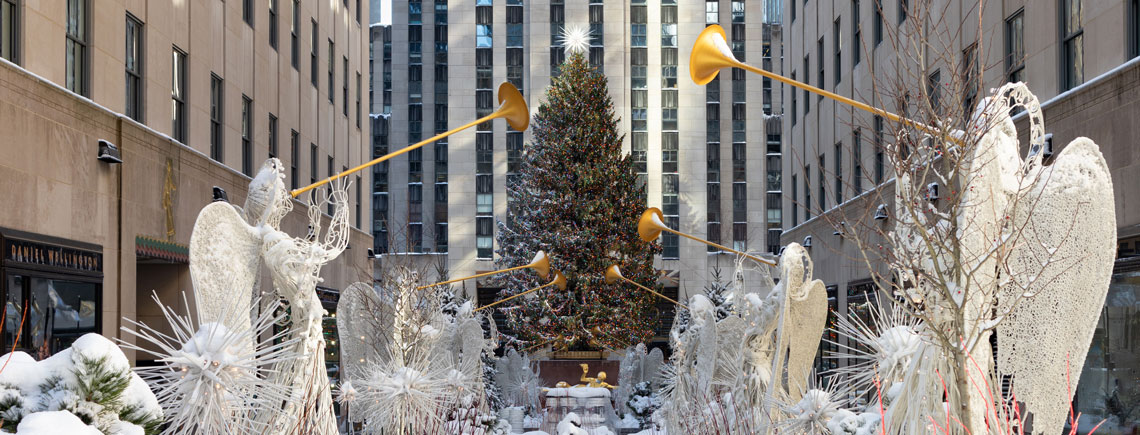Tree at Rockefeller Center
In 1931, in the deepest, darkest year of the Great Depression, a group of Italian-American workers lucky enough to have jobs constructing the Rockefeller Center pooled their money to purchase an unlit, 20-foot-tall tree to erect on the site.
Their families created "strings of cranberries, garlands of paper, and even a few tin cans" to decorate it on Christmas Eve. To a nation in the grips of an existential fear, it proved so popular that that within two years the first official Rockefeller Center Christmas tree, a 50-foot-tall specimen decorated with some 700 lights, was lighted starting an annual tradition that continues to this day.
With the opening of a skating rink below the tree in the plaza in 1936, a winter tableau was imprinted on the public’s imagination of New York City in the yuletide season. The tree became what Rockefeller Center dubbed "a holiday beacon for New Yorkers and visitors alike."
Each year since, a tree has been lighted on the plaza, becoming bigger and more grandiose. By the 1950s workers began using scaffolding to decorate the tree as larger trees were accommodated. Before the decade was over, the decorating process called for 20 workers and nine days.
This year’s tree, planted as a seedling in West Stockbridge MA 68 years ago, will be lighted with more than 50,000 multi-colored LED lights and will be crowned with a 900-pound Swarovski star featuring more than 3 million crystals as well as LED lights.
An estimated 125 million people are expected to visit the attraction.
A tree may grow in Brooklyn but Rockefeller Christmas trees certainly do not. Enter Erik Pauze, the head gardener for Rockefeller Center. For more than three decades, Pauze has scouted, nurtured and transported the Norway spruces that transform Rockefeller Center.
In an interview for Rockefeller Center Magazine Eric Pauze, who succeeded David Murbach as scout for the annual Christmas tree, reported that not much has changed since he assumed the job.
Pauze, who started as a summer helper at Rockefeller Center when in college in 1988, said identifying new trees goes on all year. “Almost every day, I’m thinking about this year’s tree, next year’s tree, and maybe the tree after that,” he was quoted as saying.
Indeed he identified this year’s tree, a Norway spruce growing in the yard of West Stockbridge MA homeowner Earl Albert, four years ago.
“I came from getting gas after staying overnight tree searching. I saw the beautiful Norway Spruce as I drove down the road and it was right in front of me. I knocked on the door and met Earl Albert. I asked if he would someday consider donating the tree to Rockefeller Center. His answer was immediately yes.”
Trees are traditionally donated to Rockefeller Center which in turn donates the lumber after display. Once the holiday season is over, this year’s tree will be milled into lumber that will support Habitat for Humanity projects.
Pauze explained that he looks for a tree people “would want in your living room but on a grander scale. It’s got that nice, perfect shape all around … it needs to instantly put a huge smile on their faces. It needs to evoke that feeling of happiness.”
While the Norway Spruce is an invasive species and is being rooted out in many communities, Pauze says it is “great for the scale it can achieve” and “stands there nice and proud as the tree should. This year’s tree is perfect all around. It has that wonderful Christmas tree shape all the way to the top.”
In the years since identifying the Albert tree, Pauze checked on it periodically. This year he asked Albert if he could start feeding and watering the tree. “I came up quite often to feed the tree and every time I got out of the car, I smiled and knew it was the right one for Rockefeller Center,” he said.
The tree, the first to come from Massachusetts since 1959, standing 74 feet tall and weighing about 11 tons, was prepared for its journey to Rockefeller Center by having its boughs carefully bound up. It is expected to arrive in the city November 9th and will be lit on December 4th. It will be on view until mid-January.
It’s place in Rockefeller Center’s history would no doubt delight Earl Albert’s wife, Lesley, who died in 2020, the same year that Pauze identified the tree. The couple, married in 1968, delighted in holidays and Leslie was renowned for creating the “the biggest 4th of July gatherings, amazing Christmas parties, Thanksgiving feasts and … even could make an everyday lunch feel special. She especially loved Christmas and the 4th of July, (and) celebrated both with grandeur,” according to her obituary.
How much grandeur could she hope for than 50,000 lights and a 900-hundred-pound Swarovski star?


